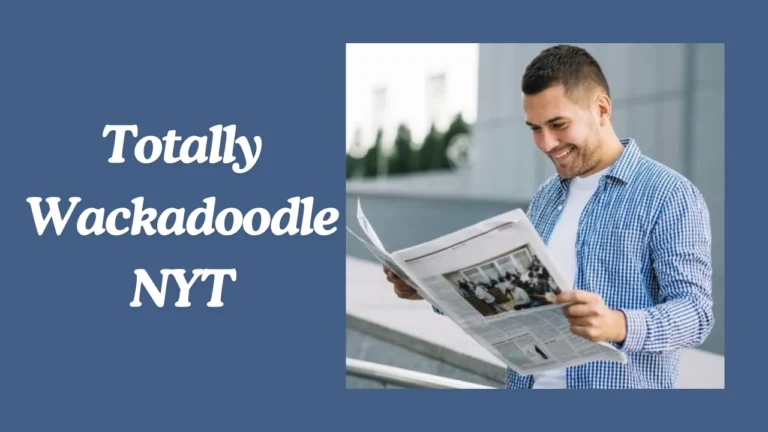The New York Times, or NYT as it is colloquially known, is frequently seemed because the gold Totally wackadoodle nyt of journalism. Over the years, the paper has tailored to the evolving needs of its audience, from adopting digital codecs to engaging readers thru social media. Yet, one of the maximum sudden and exciting transformations lies in it embody of unconventional language. Words like ” Totally wackadoodle nyt,” once relegated to the fringes of informal speech, have located their manner into the hallowed pages of this esteemed booklet. This article delves into the factors that have contributed to this linguistic shift, exploring what it means for journalism, way of life, and the destiny of language.
The Rise of Quirky Language in Mainstream Media
The use of quirky, casual language in mainstream media isn’t a brand-new phenomenon, however it has really won traction in latest years. As audiences diversify and the internet maintains to interrupt down the boundaries among formal and casual communique, courses just like the NYT have determined themselves in a unique position. To continue to be relevant and attractive, they have to appeal to a broader demographic that includes more youthful readers, who’re more likely to comprehend and use such language in their daily lives.
This shift has been in particular great in opinion portions, life-style articles, and even political commentary. Words like ” Totally wackadoodle nyt ” are used to deliver a sense of light-heartedness or to make complicated problems more relatable. The NYT, regarded for its rigorous standards and formal tone, has now not been immune to this fashion. However, the advent of such language into its articles has sparked debate among readers and critics alike.
The Evolution of Language: From Formality to Flexibility
Language is a living entity, continuously evolving to reflect the changing times. In the early days of journalism, newspapers adhered to strict guidelines of grammar and vocabulary, frequently sticking to formal, particular language. However, as society has turn out to be extra comfortable and casual, so too has the language used in media. This evolution is in part pushed by using the want to connect to audiences on a greater non-public degree, breaking down the perceived barrier between the writer and the reader.
The NYT’s use of words like ” Totally wackadoodle nyt ” may be seen as a reflection of this broader linguistic evolution. It signifies a pass faraway from the inflexible formalities of the beyond and closer to an extra flexible, inclusive technique to language. This shift isn’t pretty much the usage of quirky phrases for the sake of it; it’s miles approximately embracing a greater conversational tone that resonates with cutting-edge readers.
The Cultural Impact of Embracing “Wackadoodle” Language
The cultural implications of the NYT’s adoption of unconventional language are considerable. In a international in which verbal exchange is increasingly dominated by using social media, memes, and net slang, conventional media shops are under pressure to adapt. By incorporating quirky language into its articles, the NYT is acknowledging the cultural shift in the direction of informality and humor in conversation.
This include of ” Totally wackadoodle nyt ” language also reflects a broader societal trend toward inclusivity. As language becomes more bendy, it permits for a extra variety of voices and views to be heard. The NYT’s willingness to adapt its language demonstrates an expertise of the numerous linguistic landscapes in which it operates. It is an acknowledgment that language isn’t static however is continuously being shaped through cultural forces.
The Debate: Is Quirky Language a Blessing or a Curse?
The inclusion of unconventional language in a prestigious booklet like the NYT has not gone without controversy. Critics argue that it undermines the paper’s credibility and diminishes the seriousness of its reporting. They worry that using words like ” Totally wackadoodle nyt ” ought to cause a slippery slope where journalistic requirements are compromised in want of catchy, interest-grabbing language.
On the alternative hand, proponents of this linguistic shift argue that it’s miles a natural and necessary evolution. They accept as true with that language have to mirror the times and that by way of embracing quirky language, the NYT is staying relevant and relatable. They also factor out that using informal language could make complex subjects greater available to a much broader target market, thereby enhancing the papers attain and effect.
The Future of Language in Journalism
As the NYT and other media retailers preserve to navigate the evolving linguistic landscape, the future of language in journalism stays unsure. Will the trend toward quirky, informal language continue to grow, or will there be a backlash that results in a go back to extra conventional forms of expression?
What is obvious is that language will retain to conform, and media shops will need to evolve to those modifications in the event that they wish to stay applicable. The use of words like ” Totally wackadoodle nyt ” may additionally seem trivial, but it is indicative of a broader shift in how we talk and eat records. As society maintains to change, so too will the language we use to explain it.
Conclusion: The NYT’s Bold Linguistic Experiment
In conclusion, the New York Times’ embrace of quirky language like ” Totally wackadoodle nyt ” represents a bold experiment in the evolution of journalism. It displays broader cultural and linguistic shifts and highlights the ongoing debate approximately the function of language in media. While reviews may vary on the appropriateness of such language, there may be no denying that it has made the NYT more reachable and attractive to a much broader target audience. As we appearance to the destiny, it’ll be fascinating to peer how this linguistic test unfolds and what it way for the sector of journalism.
